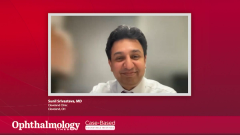
Steroid Implants for Chronic Postoperative Uveitis
Sunil Srivastava, MD, shares his experience using dexamethasone and fluocinolone acetonide implants to manage chronic non-infectious uveitis.
This is a video synopsis of a discussion involving Sunil Srivastava, MD, a prominent specialist in the field. The focus is on intraocular implants and various therapeutic options for managing macular edema, particularly postoperative cases.
The conversation delves beyond topical therapy, exploring alternative choices such as periocular steroid injections. While effective, the discussion acknowledges the higher risk of intraocular pressure rise associated with this method. Intravitreal therapy, specifically the dexamethasone implant, is highlighted as a favorable short-term solution, lasting up to six months.
Concerns about pressure rises persist with intravitreal therapies, prompting a shift towards long-acting options for chronic cases. Suprachoroidal steroids emerge as a viable choice for uveitic macular edema, with studies like PEACHTREE and MAGNOLIA supporting their effectiveness.
In chronic-based therapy, the discussion outlines two main options: the injectable fluocinolone acetonide implant and the surgical fluocinolone acetonide implant. The latter involves a more invasive approach, often reserved for specific cases. Dr. Srivastava emphasizes the need for caution and continuous monitoring, especially for potential pressure-related complications.
The panelist underscores the importance of a comprehensive clinical exam and history to rule out infections before initiating any form of therapy. Throughout the discussion, Dr. Srivastava provides valuable insights based on his extensive experience, balancing the advantages and limitations of each therapeutic approach.
As with any medical intervention, close attention to individual patient characteristics and ongoing monitoring for complications, particularly intraocular pressure, remains paramount. This comprehensive overview serves as a valuable resource for practitioners navigating the nuanced landscape of macular edema management.
Video synopsis is AI-generated and reviewed by Ophthalmology Times® editorial staff.
Newsletter
Don’t miss out—get Ophthalmology Times updates on the latest clinical advancements and expert interviews, straight to your inbox.






